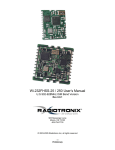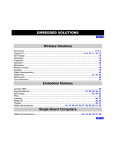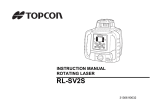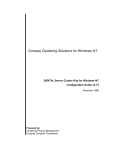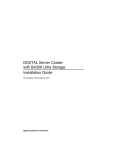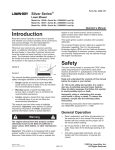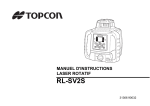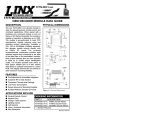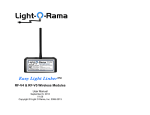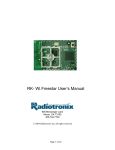Download EVM-915-250 Data Guide
Transcript
EVM-915-250
Data Guide
!
Warning: Linx radio frequency ("RF") products may be used to
control machinery or devices remotely, including machinery or devices
that can cause death, bodily injuries, and/or property damage if
improperly or inadvertently triggered, particularly in industrial settings or
other applications implicating life-safety concerns. No Linx Technologies
product is intended for use in any application without redundancies
where the safety of life or property is at risk.
The customers and users of devices and machinery controlled with
RF products must understand and must use all appropriate safety
procedures in connection with the devices, including without limitation,
using appropriate safety procedures to prevent inadvertent triggering by
the user of the device and using appropriate security codes to prevent
triggering of the remote controlled machine or device by users of other
remote controllers.
Do not use this or any Linx product to trigger an action directly
from the data line or RSSI lines without a protocol or encoder/
decoder to validate the data. Without validation, any signal from
another unrelated transmitter in the environment received by the module
could inadvertently trigger the action.
All RF products are susceptible to RF interference that can prevent
communication. RF products without frequency agility or hopping
implemented are more subject to interference. This module does have
a frequency hopping protocol built in, but the developer should still be
aware of the risk of interference.
Do not use any Linx product over the limits in this data guide.
Excessive voltage or extended operation at the maximum voltage could
cause product failure. Exceeding the reflow temperature profile could
cause product failure which is not immediately evident.
Do not make any physical or electrical modifications to any Linx
product. This will void the warranty and regulatory and UL certifications
and may cause product failure which is not immediately evident.
Table of Contents
1^
2^
3^
4^
4^
5^
6^
6^
7^
7^
8^
8^
9^
10^
11^
11^
Description
Ordering Information
Electrical Specifications
Pin Assignments
Pin Descriptions
PCB Footprint
Board Layout Guidelines
Power Supply Requirements
Schematic Diagram
Helpful Application Notes from Linx
Usage Guidelines for FCC Compliance
Additional Testing Requirements
Information to the user
Product Labeling
Antenna Selection
Module Modification
250 Series Transceiver
Evaluation Module
Data Guide
Figure 1: 250 Series Evaluation Module
Description
The EVM-915-250 features the 250 Series transceiver module in a modular
approved solution. It is designed to greatly simplify implementation of the
250 Series module into a working design without the complications of FCC
testing.
The 250 Series RF transceiver module is designed for reliable bi-directional
transfer of digital data over distances of up to 4 miles (6.4km) line of sight. It
implements a Frequency Hopping Spread Spectrum (FHSS) protocol along
with networking and assured delivery features. The module automatically
handles all radio functions resulting in a UART-to-antenna wireless link.
The module has a Universal Asynchronous Receiver Transmitter (UART)
serial interface that can be directly connected to microcontrollers, RS-232
converters or USB adaptors. All configuration settings and data are
accessed through the UART interface.
– 1 –
Revised 3/18/2015
Ordering Information
Electrical Specifications
Electrical Specifications
Ordering Information
Product Part No.
Description
Radiotronix Part No.
EVM-915-250-FCR
250 Series Evaluation
Module, Right Angle
RP-SMA Connector, FCC
Approved
Wi.232FHSS-250-FCC-RA-R
250 Series Evaluation
Module, Straight RP-SMA
Connector, FCC Approved
Wi.232FHSS-250-FCC-ST-R
EVM-915-250-CFR
250 Series Evaluation
Module, Right Angle
RP-SMA Connector, Mexico
CoFeTel Approved
Wi.232FHSS-250-FCC-CFTC-RA-R
EVM-915-250-CFS
250 Series Evaluation
Module, Straight RP-SMA
Connector, Mexico CoFeTel
Approved
Wi.232FHSS-250-FCC-CFTC-ST-R
EVM-915-250-FCS
Parameter
Symbol
Min.
Operating Voltage
VCC
4
Supply Current
ICC
Typ.
Max.
Units
12
VDC
Receive
25
mA
Transmit, Po = 8dBm
60
mA
Transmit, Po = 23.5dBm
200
mA
927.8
MHz
Power Supply
RF Section
Operating Frequency Band
FC
902.2
Number of Channels
32
Chan.
Channel Spacing
750
kHz
Max Data Rate
115.2
kbps
Receiver Section
Figure 2: Ordering Information
Receiver Sensitivity
Note: Please see the TRM-915-R250 data guide for complete
information about the module, detailed specifications and configuration
commands.
9.6kbps
–105
dBm
38.4kbps
–102
dBm
153.6kbps
–100
dBm
Transmitter Section
Warning: This product incorporates numerous static-sensitive
components. Always wear an ESD wrist strap and observe proper ESD
handling procedures when working with this device. Failure to observe
this precaution may result in module damage or failure.
Max Output Power
PO
23.5
Harmonic Emissions
PH
–50
24
dBm
dBc
Frequency Deviation
FDEV
50
kHz
Digital Interface
Output
Logic Low
VOL
0
0.4
VDC
Logic High
VOH
2.5
VCC
VDC
Logic Low
VIL
0
0.3*VCC
VDC
Logic High
VIH
0.7*VCC
VCC
VDC
–40
85
°C
Input
Environmental
Operating Temperature
Range
Figure 3: Electrical Specifications
– 2 –
– 3 –
Notes
Pin Assignments
Pin Descriptions Continued
1
24
2
23
3
22
4
21
5
20
6
19
7
18
8
17
9
16
10
15
11
14
12
13
Pin Number
Name
I/O
Description
6, 7, 8, 9, 10,
15, 16, 17, 18
NC
—
No Electrical Connection. Do not connect
any traces to these lines.
11, 12, 13,
14, 23, 24
GND
—
Ground
19
EX
O
Exception Output. A mask can be set
to take this line high when an exception
occurs. The line is lowered when the
exception register is read (regEXCEPTION)
20
RSSI
O
This line outputs an analog voltage that is
proportional to the strength of the incoming
signal.
21
CMD_RSP
O
Command Response. This line is low when
the data on the TXD line is a response to a
command and not data received over the
air.
22
BE
O
Buffer Empty. This line goes high when the
UART input buffer is empty, indicating that
all data has been transmitted.
Figure 5: 25 Series EVM Module Pin Descriptions
Figure 4: 25 Series EVM Module Pin Assignments (Top View)
PCB Footprint
1.53”
(38.86)
Pin Descriptions
0.50”
(12.7)
Pin Descriptions
Pin Number
Name
I/O
Description
1
VCC
—
Supply Voltage
2
RXD
I
UART Receive Data Input. This is the input
line for the configuration commands as well
as data to be sent over the air.
3
TXD
O
UART Transmit Data Output. This is the
output line for the configuration command
responses as well as the data received over
the air.
O
UART Clear To Send, active low. This line
indicates to the host microcontroller when
the module is ready to accept data. When
CTS is high, the module is busy. When CTS
is low, the module is ready for data.
I
Command Input. This line sets the serial
data as either command data to configure
the module or packet data to be sent over
the air. Pull low for command data; pull high
for packet data.
4
5
CTS
CMD
– 4 –
1
24
1.94”
(49.28)
0.10”
(2.54)
Ø0.04” x 24
(1.02)
0.34”
(8.64)
0.07”
(1.78)
1.40”
(35.56)
0.06”
(1.52)
Figure 6: 250 Series EVM Module PCB Footprint
– 5 –
Schematic Diagram
R2
1K
PR_PKT
TXD
CMD_RSP
EX
1
2
3
4
5
6
7
8
9
10
JP3
1
2
3
4
26
25
24
MOD1
GND
GND
ANT
GND
RXD
CTS
NC
NC
BE
CMD
RSSI
PR_PKT
TXD
NC
NC
NC
RESET
C2D
NC
CMD_RSP
EX
23
22
21
20
19
18
17
16
15
14
EX
RSSI
CMD_RSP
BE
RXD
CTS
GND
BE
CMD
RSSI
12
11
10
9
8
7
6
5
4
3
2
1
PR_PKT
J1
GND
GND
JP1
JP2
12
11
10
9
8
7
6
5
4
3
2
1
GND
CMD
CTS
TXD
RXD
VIN
GND
11
12
13
When possible, separate RF and digital circuits into different PCB regions.
GND
120NH
C4
4.7uF
Bypass caps should be low ESR ceramic types and located directly
adjacent to the pin they are serving.
GND
C5
0.1uF
GND
IN
OUT
L3
3
120NH
GND
1
GND
VIN
VCC
U1
L1
2
Make sure internal wiring is routed away from the module and antenna and
is secured to prevent displacement.
R1
1K
VCC
VCC
120NH
C3
47uF
T
The module should, as much as reasonably possible, be isolated from
other components on your PCB, especially high-frequency circuitry such as
crystal oscillators, switching power supplies, and high-speed bus lines.
L2
VCC
VCC
VCC
The module’s design makes integration straightforward; however, it
is still critical to exercise care in PCB layout. Failure to observe good
layout techniques can result in a significant degradation of the module’s
performance. Grounding, filtering, decoupling, routing and PCB stack-up
are all important considerations for any RF design. Some basic design
guidelines are provided here.
GND
GND
GND
Board Layout Guidelines
GNDGND
GND
C6
4.7uF
GND
C7
0.1uF
GND
Figure 8: 25 Series EVM Module Schematic
In some instances, a designer may wish to encapsulate or “pot” the
product. Since such compounds can considerably impact RF performance
and the ability to rework or service the product, it is the responsibility of the
designer to evaluate and qualify the impact and suitability of such materials.
Power Supply Requirements
Vcc TO
MODULE
It is not the intention of this manual to address in depth many of the issues
that should be considered to ensure that the modules function correctly
and deliver the maximum possible performance. As you proceed with your
design, you may wish to obtain one or more of the following application
notes which address in depth key areas of RF design and application of
Linx products. These application notes are available online at
www.linxtechnologies.com or by contacting Linx.
10Ω
Vcc IN
+
The transceiver incorporates a precision
low-dropout regulator which allows operation
over a wide input voltage range. Despite this
regulator, it is still important to provide a supply
that is free of noise. Power supply noise can
significantly affect the module’s performance, so
providing a clean power supply for the module
should be a high priority during design.
Helpful Application Notes from Linx
10µF
Figure 7: Supply Filter
A 10Ω resistor in series with the supply followed by a 10μF tantalum
capacitor from Vcc to ground helps in cases where the quality of supply
power is poor (Figure 7). This filter should be placed close to the module’s
supply lines. These values may need to be adjusted depending on the
noise present on the supply line.
Helpful Application Note Titles
Note Number
Note Title
AN-00100
RF 101: Information for the RF Challenged
AN-00126
Considerations for Operation Within the 902–928MHz Band
AN-00130
Modulation Techniques for Low-Cost RF Data Links
AN-00140
The FCC Road: Part 15 from Concept to Approval
AN-00160
Considerations for Sending Data Over a Wireless Link
AN-00500
Antennas: Design, Application, Performance
AN-00501
Understanding Antenna Specifications and Operation
Figure 9: Helpful Application Notes
– 6 –
– 7 –
Usage Guidelines for FCC Compliance
Information to the user
The 250 Series module is provided with an FCC, Industry Canada and
Mexico COFETEL Modular Certification. This certification shows that the
module meets the requirements of FCC Part 15 and Industry Canada
license-exempt RSS standards for an intentional radiator. The integrator
does not need to conduct any further testing under these rules provided
that the following guidelines are met:
The following information must be included in the product’s user manual.
•
An approved antenna must be directly coupled to the module’s
RP-SMA connector through an approved coaxial extension cable.
•
Alternate antennas can be used, but may require the integrator to
perform certification testing.
•
The module must not be modified in any way. Coupling of external
circuitry must not bypass the provided connectors.
•
End product must be externally labeled with “Contains FCC ID:
Q7V-3F090009X / IC: 5589A-3F090009”.
•
The end product’s user’s manual must contain an FCC statement
equivalent to that listed on page 9 of this data guide.
•
The antenna used for this transceiver must not be co-located or
operating in conjunction with any other antenna or transmitter.
•
The integrator must not provide any information to the end-user on
how to install or remove the module from the end-product.
Note: The integrator is required to perform unintentional radiator testing
on the final product per FCC sections 15.107 and 15.109 and IC
RSS-GEN.
Any changes or modifications not expressly approved by Linx Technologies
could void the user’s authority to operate the equipment.
Additional Testing Requirements
The modules have been tested for compliance as an intentional radiator,
but the integrator is required to perform unintentional radiator testing
on the final product per FCC sections 15.107 and 15.109 and Industry
Canada license-exempt RSS standards. Additional product-specific testing
might be required. Please contact the FCC, Industry Canada or ANATEL
regarding regulatory requirements for the application. Ultimately is it the
integrator’s responsibility to show that their product complies with the
regulations applicable to their product.
– 8 –
FCC / IC NOTICES
This product contains FCC ID: Q7V-3F090009X / IC: 5589A-3F090009
This device complies with Part 15 of the FCC rules and Industry Canada licenseexempt RSS standards. Operation of this device is subject to the following two
conditions:
1. This device may not cause harmful interference, and
2. this device must accept any interference received, including interference that
may cause undesired operation.
This equipment has been tested and found to comply with the limits for a Class
B digital device, pursuant to Part 15 of the FCC Rules. These limits are designed
to provide reasonable protection against harmful interference in a residential
installation. This equipment generates, uses and can radiate radio frequency
energy and, if not installed and used in accordance with the instructions,
may cause harmful interference to radio communications. However, there is
no guarantee that interference will not occur in a particular installation. If this
equipment does cause harmful interference to radio or television reception, which
can be determined by turning the equipment off and on, the user is encouraged
to try to correct the interference by one or more of the following measures:
•
•
•
•
Reorient or relocate the receiving antenna.
Increase the separation between the equipment and receiver.
Connect the equipment into an outlet on a circuit different from that to which
the receiver is connected.
Consult the dealer or an experienced radio/TV technician for help.
Any modifications could void the user’s authority to operate the equipment.
Le présent appareil est conforme aux CNR d’Industrie Canada applicables
aux appareils radio exempts de licence. L’exploitation est autorisée aux deux
conditions suivantes:
1. l’appareil ne doit pas produire de brouillage, et
2. ’utilisateur de l’appareil doit accepter tout brouillage radioélectrique subi,
même si le brouillage est susceptible d’en compromettre le fonctionnement.
– 9 –
Product Labeling
Antenna Selection
The end product must be labeled to meet the FCC product label
requirements. It must have the below or similar text:
Under FCC, Industry Canada, COFETEL and ANATEL regulations,
this radio transmitter may only operate using an antenna of a type and
maximum (or lesser) gain approved for the transmitter by the FCC, Industry
Canada and ANATEL. To reduce potential radio interference to other users,
the antenna type and its gain should be so chosen that the equivalent
isotropically radiated power (e.i.r.p.) is not more than that necessary for
successful communication.
Contains FCC ID: Q7V-3F090009X / IC: 5589A-3F090009
The Brazil version must contain:
Anatel: 0946-08-4266
The label must be permanently affixed to the product and readily visible to
the user. ‘‘Permanently affixed’’ means that the label is etched, engraved,
stamped, silkscreened, indelibly printed, or otherwise permanently marked
on a permanently attached part of the equipment or on a nameplate of
metal, plastic, or other material fastened to the equipment by welding,
riveting, or a permanent adhesive. The label must be designed to last
the expected lifetime of the equipment in the environment in which the
equipment may be operated and must not be readily detachable.
The EVM-915-250-FCx radio transmitter has been approved by the FCC
and Industry Canada, the EVM-915-250-CFx and the Wi.232FHSS250B-xx-R has been approved by ANATEL to operate with the antenna
types listed in Figure 10 with the maximum permissible gain and required
antenna impedance for each antenna type indicated. Antenna types not
included in this list, having a gain greater than the maximum gain indicated
for that type, are strictly prohibited for use with this device.
Antennas
Linx Part Number
Type
Gain
Impedance
ANT-916-CW-QW
¼ Wave Whip
1.84dBi
50Ω
ANT-916-CW-HW
½ Wave Dipole Helical
1.83dBi
50Ω
Figure 10: Antenna Selection
An approved antenna must be directly attached to the module’s reversepolarity SMA connector in the final application to inherit the modular
certifications.
Module Modification
The module must not be physically altered in any way. If any connections
are made to the modules that bypass the module pins, socket or antenna
connector, none of the modular certifications can be inherited.
– 10 –
– 11 –
Linx Technologies
159 Ort Lane
Merlin, OR, US 97532
Phone: +1 541 471 6256
Fax: +1 541 471 6251
www.linxtechnologies.com
Disclaimer
Linx Technologies is continually striving to improve the quality and function of its products. For this reason, we
reserve the right to make changes to our products without notice. The information contained in this Data Guide
is believed to be accurate as of the time of publication. Specifications are based on representative lot samples.
Values may vary from lot-to-lot and are not guaranteed. “Typical” parameters can and do vary over lots and
application. Linx Technologies makes no guarantee, warranty, or representation regarding the suitability of any
product for use in any specific application. It is the customer’s responsibility to verify the suitability of the part for
the intended application. NO LINX PRODUCT IS INTENDED FOR USE IN ANY APPLICATION WHERE THE SAFETY
OF LIFE OR PROPERTY IS AT RISK.
Linx Technologies DISCLAIMS ALL WARRANTIES OF MERCHANTABILITY AND FITNESS FOR A PARTICULAR
PURPOSE. IN NO EVENT SHALL LINX TECHNOLOGIES BE LIABLE FOR ANY OF CUSTOMER’S INCIDENTAL OR
CONSEQUENTIAL DAMAGES ARISING IN ANY WAY FROM ANY DEFECTIVE OR NON-CONFORMING PRODUCTS
OR FOR ANY OTHER BREACH OF CONTRACT BY LINX TECHNOLOGIES. The limitations on Linx Technologies’
liability are applicable to any and all claims or theories of recovery asserted by Customer, including, without
limitation, breach of contract, breach of warranty, strict liability, or negligence. Customer assumes all liability
(including, without limitation, liability for injury to person or property, economic loss, or business interruption) for
all claims, including claims from third parties, arising from the use of the Products. The Customer will indemnify,
defend, protect, and hold harmless Linx Technologies and its officers, employees, subsidiaries, affiliates,
distributors, and representatives from and against all claims, damages, actions, suits, proceedings, demands,
assessments, adjustments, costs, and expenses incurred by Linx Technologies as a result of or arising from any
Products sold by Linx Technologies to Customer. Under no conditions will Linx Technologies be responsible for
losses arising from the use or failure of the device in any application, other than the repair, replacement, or refund
limited to the original product purchase price. Devices described in this publication may contain proprietary,
patented, or copyrighted techniques, components, or materials. Under no circumstances shall any user be
conveyed any license or right to the use or ownership of such items.
©2015 Linx Technologies. All rights reserved.
The stylized Linx logo, Wireless Made Simple, WiSE, CipherLinx and the stylized CL logo are trademarks of Linx Technologies.












